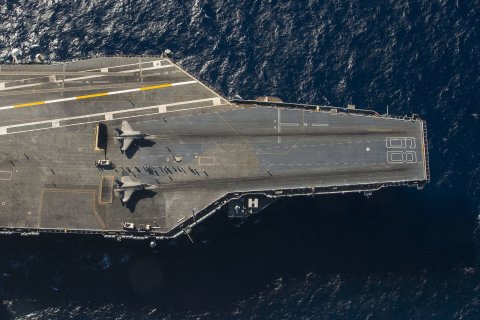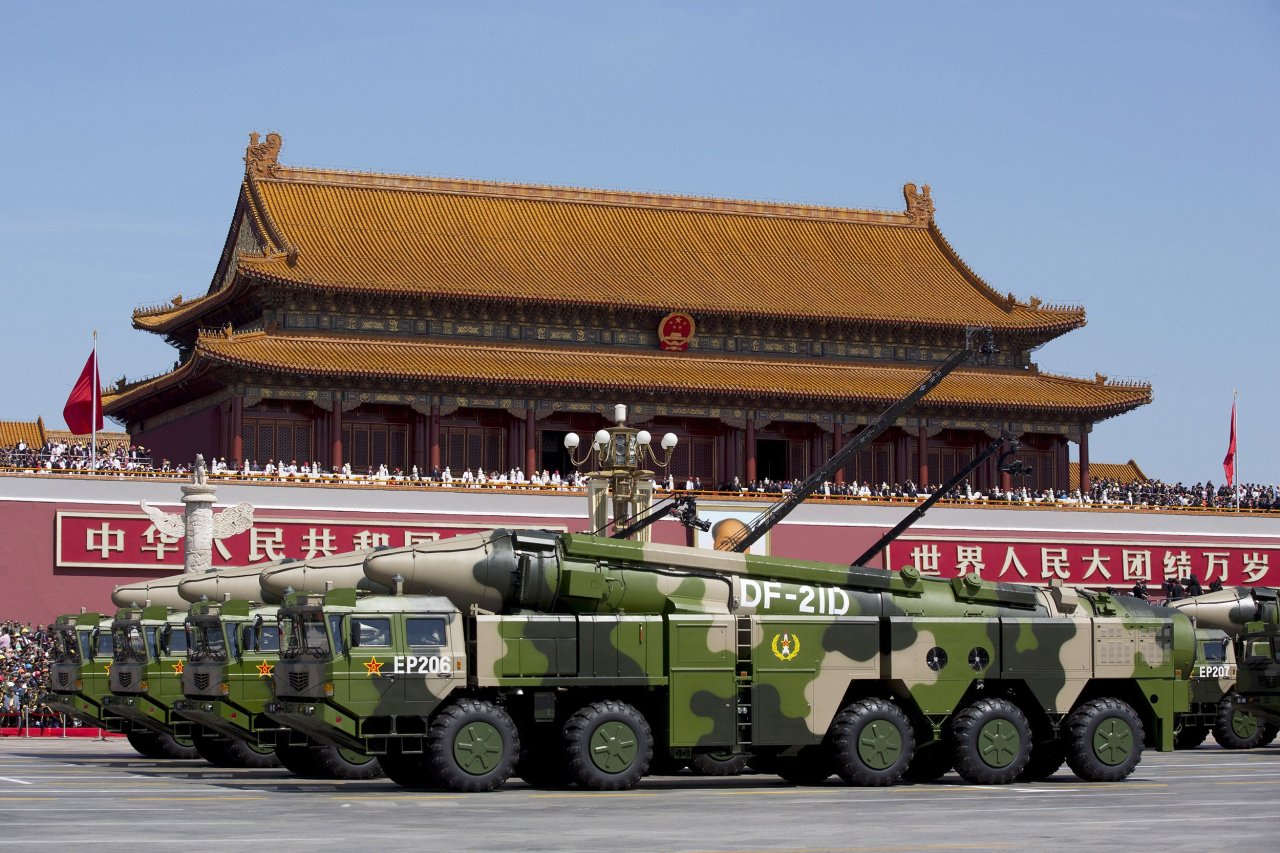In late 1995, escalating Chinese threats against Taiwan prompted President Bill Clinton to stage a show of American support for the beleaguered island that Beijing's leaders couldn't ignore. Clinton sent two aircraft carrier battle groups steaming into the conflict zone, their heavily armed fighter jets poised on deck for takeoff. One battle group, led by the carrier USS Nimitz, sailed down the middle of the Taiwan Strait, less than 50 miles from the Chinese mainland, while the second stood in reserve off Taiwan's eastern coast. Chinese officials decried what they called "foreign intervention" in their long-standing claim to Taiwan. But lacking the weapons to deter the American warships, they had little choice but to heed Clinton's show of force and back away.
China's loss of face in the Taiwan crisis spurred its development of a long-anticipated family of anti-ship missiles unveiled at a military parade in September. One of the missiles, the Dongfeng-21D, has a maneuverable warhead that can seek and close in on its target at 10 times the speed of sound, making it almost impossible to intercept. According to U.S. naval intelligence, the missile can disable and possibly sink American carriers. Another anti-ship missile in the parade, the YJ-12, skims the surface of the water and then accelerates to more than twice the speed of sound as it homes in on its target.
With Chinese military officials warning their American counterparts of possible clashes in the contested waters of the South China Sea, some military experts are now seriously questioning whether Beijing's new missiles have rendered the aircraft carriers and their air wings ineffective in the event of a major conflict with China. With the Navy planning to order a new fleet of expensive carriers, key lawmakers are questioning whether that is wisest investment. "We simply cannot afford to pay $12.9 billion for a single ship," says Republican Senator John McCain of Arizona, chairman of the Senate Armed Services Committee.
The Navy doesn't like any suggestion that its carriers may be going the way of the tall ship. There is no piece of military hardware more emblematic of American power than the aircraft carrier. While China, Russia and a few other countries have one or two smaller carriers, none approaches the size or capabilities of America's fleet of 10 so-called supercarriers. These nuclear-powered behemoths, longer than three football fields, and carrying up to 90 warplanes and a crew of 5,000, are seagoing airbases that have projected American power to the farthest corners of the globe since the end of World War II. They are the symbol of American naval power, and the Navy reaffirmed its commitment to the carrier force earlier this month with a request for continued funding of three new Ford-class aircraft carriers in the Pentagon's $583 billion fiscal 2017 budget proposal.
Yet China's new missiles—and fresh intelligence that Russia, Iran and North Korea are working on similar weapons—are prompting an unprecedented debate over the future of carrier-based warfare. Some skeptics now argue these iconic ships and their attack aircraft are out of date. Today's carriers, they note, were built during the Cold War to stay far away from enemy territory yet accommodate heavy, long-range strategic bombers like the A-3 Skywarrior, which could fly up to 2,000 miles to strike targets deep inside the Soviet Union.
But after the Soviet Union's collapse in 1991, the Navy dropped its requirements for long-range aircraft. Under the assumption that its carriers could sail unchallenged across the world's oceans in a post–Cold War world, the Navy opted for lighter attack aircraft like the F-18 Super Hornet, with a range of no more than 500 miles. That approach worked well until a few years ago, when China fielded its Dongfeng-21D missile, with a range of 900 miles that puts U.S. carriers squarely within its kill zone. "We essentially missed the boat on our assumptions in the 1990s," says Jerry Hendrix, a retired Navy captain who has studied the role of carriers in battle.
Hendrix, now a defense analyst at the Washington-based Center for a New American Security and the leading critic of current carrier doctrine, argues the Navy should scrap plans to buy the larger Ford-class carriers at a cost of around $13 billion each, and instead spend $5 billion each for several smaller carriers that could operate safely outside the range of China's killer missiles. And instead of current and future shorter-range carrier-based aircraft, he's calling for heavily armed combat drones that can fly longer distances. "There's two decisions the Navy should be making right now—get away from the Ford-class design because the ship is too damn expensive and get us back to something that is cheaper, and buy back range, which means purchasing an aircraft that can actually span the missile's 900-mile distance."
The Navy has no such long-range aircraft and no plans to buy one. Over the next few years, it plans to buy dozens of F-35Cs, the carrier-based variant of the next-generation stealth fighter that has been plagued by mechanical problems, production delays and huge cost overruns. The first F-35C squadron is on schedule to be operational by 2018, but the fighters will have a range of no more than 650 miles—still well within the range of China's carrier-killer missile.

In what would be a bold and controversial move, Hendrix suggests the Navy dump the troubled F-35C variant and replace it with carrier-based killer drones that would cost far less and fly much farther and longer that the manned F-35Cs. The Navy, he notes, has an experimental drone that can fly 1,500 miles loaded with 4,000 pounds of precision munitions. By enlarging that model's wingspan and weight, he says, it could carry 6,000 pounds of smart munitions and fly 2,000 miles. An unmanned tanker version could refuel the killer drones in flight, increasing their range. "These are all things that we can afford within the budget that we have now," he says.
At a time when the threat from Chinese anti-ship missiles is growing and Pentagon budgets are shrinking, Hendrix's vision of a new carrier force—outlined in two papers he wrote last year for the Center for a New American Security—have drawn considerable attention in defense circles. But Hendrix and his supporters are up against some powerful interests, starting with the Navy, which defends the capabilities of its carriers and their air wings. Asked recently by Newsweek if China's anti-ship missiles had made U.S. carriers obsolete, Chief of Naval Operations Admiral John Richardson emphatically answered: "No!" He says the Navy's newest warships have advanced missile defense systems to counter the Chinese threat, as well as sensors and targeting technology that provide data to commanders, pilots and ship crews in real time.
"The Navy's carriers remain relevant in today's ever-changing world due to their flexibility, adaptability and lethality," says Commander William Marks, a Navy spokesman. "The aircraft carrier is still the only maritime force capable of executing the full spectrum of military operations to protect our country."
Bryan McGrath, a retired naval officer who commanded a destroyer, disputes Hendrix's claim that the new Ford-class carriers will be prohibitively expensive. For the $13 billion that each new carrier will cost, "you get a nuclear-powered air base that floats and moves and lasts for 50 years," he says. "The utility that we get from those platforms is certainly worth the costs that we pay."
He agrees with Hendrix on the challenge posed by shorter-range carrier-based aircraft. "Jerry is right," he says. "The airplanes that currently fly off the aircraft carriers have insufficient range for the threat we will face in the next decade." But he parts company with Hendrix over the solution. Rather than scrap the F-35C, McGrath proposes making changes to its engine that will give it greater range. "Do what we've done for 70 years, which is to change the weapons system of the aircraft carrier to meet the threat," he says.
Hendrix and other defense experts are deeply skeptical that the Navy has an effective defense against the Dongfeng-21D. The Navy's defense systems, they note, are geared toward intercepting cruise missiles closing in at a horizontal trajectory. After a ballistic launch high into the atmosphere, the missile's warhead drops in on its target vertically and at hypersonic speed, making it virtually impossible to intercept. "If there is a way to defend against it, I'm not aware of it," Hendrix says.
He says there is one more factor that argues against an expensive new fleet of aircraft carriers—the unacceptable political cost if one of them is destroyed. He says current and former administration officials have told him that if there were even a 10 percent chance that sending a carrier into battle would get it sunk or disabled, they would advise the president against it.
"The loss of an aircraft carrier, with images of a thousand American dead, or just having it disabled, with all its airplanes and radars knocked out and huge gaping holes in it, is such a heavy political blow that we probably wouldn't risk it unless it was for the actual defense of the continental United States," he says. "So we've created an asset that we cannot afford to lose because it's become such an iconic symbol of American power that to have that symbol damaged or destroyed would undermine the legitimacy of America's role in the world." And that, he says, is "the calculus that no one in uniform will talk to you about."



















